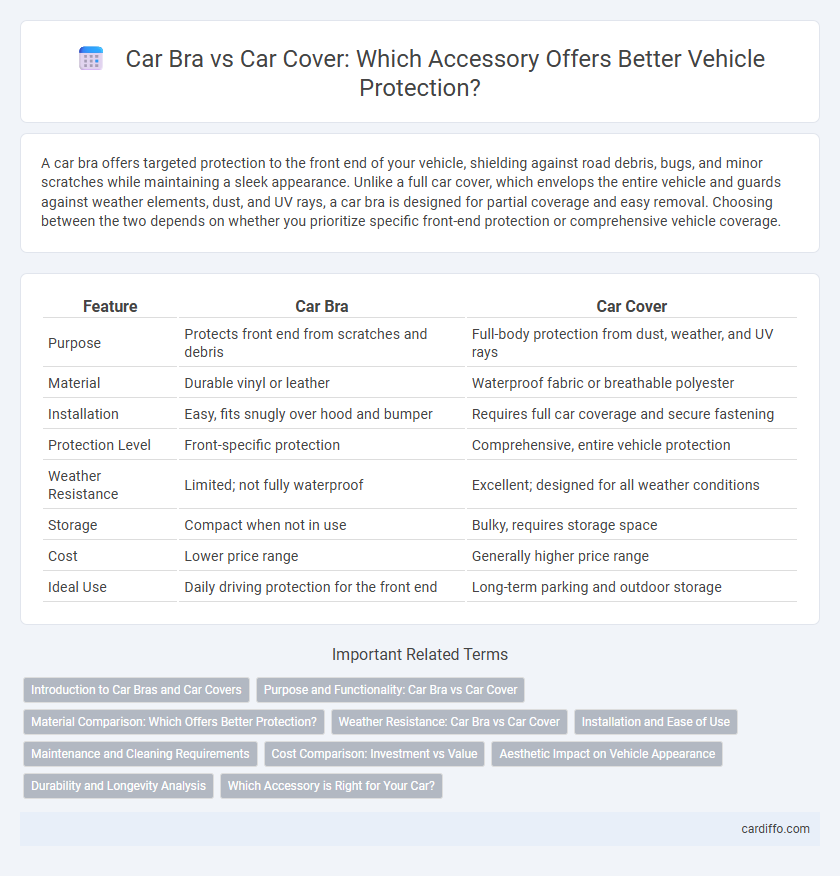A car bra offers targeted protection to the front end of your vehicle, shielding against road debris, bugs, and minor scratches while maintaining a sleek appearance. Unlike a full car cover, which envelops the entire vehicle and guards against weather elements, dust, and UV rays, a car bra is designed for partial coverage and easy removal. Choosing between the two depends on whether you prioritize specific front-end protection or comprehensive vehicle coverage.
Table of Comparison
| Feature | Car Bra | Car Cover |
|---|---|---|
| Purpose | Protects front end from scratches and debris | Full-body protection from dust, weather, and UV rays |
| Material | Durable vinyl or leather | Waterproof fabric or breathable polyester |
| Installation | Easy, fits snugly over hood and bumper | Requires full car coverage and secure fastening |
| Protection Level | Front-specific protection | Comprehensive, entire vehicle protection |
| Weather Resistance | Limited; not fully waterproof | Excellent; designed for all weather conditions |
| Storage | Compact when not in use | Bulky, requires storage space |
| Cost | Lower price range | Generally higher price range |
| Ideal Use | Daily driving protection for the front end | Long-term parking and outdoor storage |
Introduction to Car Bras and Car Covers
Car bras and car covers are essential automotive accessories designed to protect vehicles from environmental elements. Car bras, typically made from durable vinyl or leather, shield the front end of the car from road debris, insects, and minor abrasions, enhancing both protection and style. Car covers offer full-vehicle coverage with lightweight, weather-resistant materials that guard against sun damage, rain, dust, and scratches.
Purpose and Functionality: Car Bra vs Car Cover
Car bras primarily protect the front end of a vehicle from road debris, bugs, and minor abrasions while enhancing its sporty appearance. Car covers offer comprehensive protection by shielding the entire vehicle from weather elements such as rain, UV rays, dust, and bird droppings. Choosing between a car bra and a car cover depends on whether the priority is front-end protection and style or full-body preservation and weatherproofing.
Material Comparison: Which Offers Better Protection?
Car bras are typically made from durable, flexible vinyl or polyurethane, designed to shield the vehicle's front end from minor abrasions, UV rays, and insects while allowing airflow to prevent moisture buildup. Car covers are often constructed from multi-layer polyester, waterproof fabrics, or breathable materials like cotton blends, providing comprehensive all-around protection against dust, rain, snow, and environmental contaminants. For superior protection, car covers excel in full-vehicle coverage and weather resistance, whereas car bras offer targeted front-end defense mainly against road debris.
Weather Resistance: Car Bra vs Car Cover
Car bras provide targeted protection against debris and minor abrasions but offer limited weather resistance compared to car covers. Car covers are designed with waterproof and UV-resistant materials that shield the entire vehicle from rain, snow, sun damage, and dust accumulation. Choosing a car cover ensures comprehensive weather resistance, preserving the car's exterior and paint finish over time.
Installation and Ease of Use
Car bras offer a streamlined installation process, typically requiring simple attachment points such as clips or straps that secure firmly to the front bumper, making them quick to put on and remove. Car covers demand more time and effort to install, as they must be carefully draped and adjusted over the entire vehicle to ensure full protection and avoid wind-related displacement. In terms of ease of use, car bras excel for everyday front-end protection with minimal hassle, while car covers provide comprehensive coverage but require patience and careful handling during setup.
Maintenance and Cleaning Requirements
Car bras require regular washing with mild soap and water to prevent dirt and moisture buildup that can damage both the bra and the paint underneath. Car covers demand thorough cleaning and drying before storage to avoid mold and mildew growth, especially when used outdoors. Proper maintenance of both accessories extends their lifespan and protects the vehicle's exterior from environmental damage.
Cost Comparison: Investment vs Value
Car bras typically cost between $50 and $150, offering a targeted and affordable investment for protecting the front end from scratches and debris. Car covers range from $30 to over $300, with higher-priced models providing comprehensive protection against weather, dust, and UV damage, often delivering greater long-term value. Evaluating the cost versus protection needs helps determine whether the focused coverage of a car bra or the full-vehicle shield of a car cover offers the best return on investment.
Aesthetic Impact on Vehicle Appearance
Car bras enhance vehicle aesthetics by providing a sporty, aggressive look that highlights the front end while partially covering paintwork. Car covers offer full protection but can obscure the vehicle's design, leading to less visual appeal when stored or parked. Choosing between the two depends on whether the owner prioritizes a bold style statement or comprehensive coverage with minimal aesthetic impact.
Durability and Longevity Analysis
Car bras offer targeted protection against road debris and minor abrasions, made from durable vinyl that resists tearing but may degrade under prolonged UV exposure. Car covers, constructed from multi-layered fabrics like polyester or polypropylene, provide comprehensive protection against environmental factors including sun, rain, and dust, enhancing overall longevity of the vehicle's exterior. While car bras focus on front-end durability, car covers deliver broader, long-term preservation, making them ideal for extended outdoor use.
Which Accessory is Right for Your Car?
Choosing between a car bra and a car cover depends on the level of protection and usage conditions for your vehicle. A car bra primarily shields the front end from road debris, bugs, and minor abrasions during driving, making it ideal for frequent highway use. In contrast, a full car cover provides comprehensive protection against environmental elements like dust, rain, UV rays, and bird droppings, suited for long-term outdoor parking and storage.
Car Bra vs Car Cover Infographic

 cardiffo.com
cardiffo.com